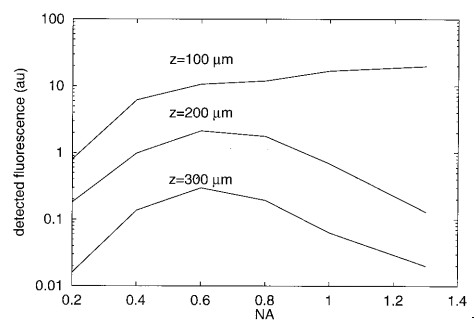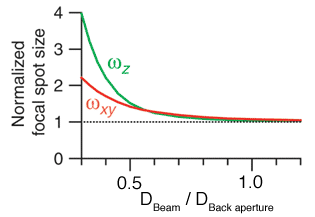Axial resolution vs numerical aperture
Recently, microscope manufacturers have been releasing ever higher NA objectives for multiphoton imaging. Although higher NA objectives should give better axial resolution, they might not be ideal for imaging deep into the brain compared to more moderate NAs.
I think the perception that higher NAs always improve images arises when people try out new, high NA objectives that have smaller back apertures than their old objectives (e.g., an Olympus 20x/0.95 NA or a Nikon 16x/0.8 NA). If the back aperature on the 25x, 1.0+ NA objective they’re trying is smaller, then suddenly they’re overfilling more than before and their axial resolution and S:N are improved. They chalk it up to the NA and swear never to go back to 0.8 NA objectives. However, their old objective might actually be better, and what they really need to work on is their scanning optics.
The key issue is this: high NA objectives bring a large portion of their light in at a high angle. This high angle results in longer paths for the excitation light to take, and this results in more scattering events. The end result is that excitation intensity decreases. This has been shown theoretically and empirically. So if you’ll be imaging deep, consider moderate NA objectives.
By contrast, underfilling the back aperture is a great way to destroy one’s axial resolution. Since the lateral resolution is relatively unaffected, this problem often goes unnoticed (see figure below, its link, and this review). If the excitation beam is less than half of the diameter of the back aperture of a 20x/0.95 NA, then the axial FWHM could be 3x what it should be, or roughly the equivilant of a 0.60 NA objective (theoretical FWHM 5.6 microns), or worse.
Even many commercially available scopes fail to overfill the large back apertures of today’s low magnification/high NA objectives. The major microscope manufacturers need their objectives to fit onto their existing microscope bodies and systems, and this is a major engineering constraint in their design for new imaging systems.



[…] recap the previous post on axial resolution and numerical aperture in two-photon […]